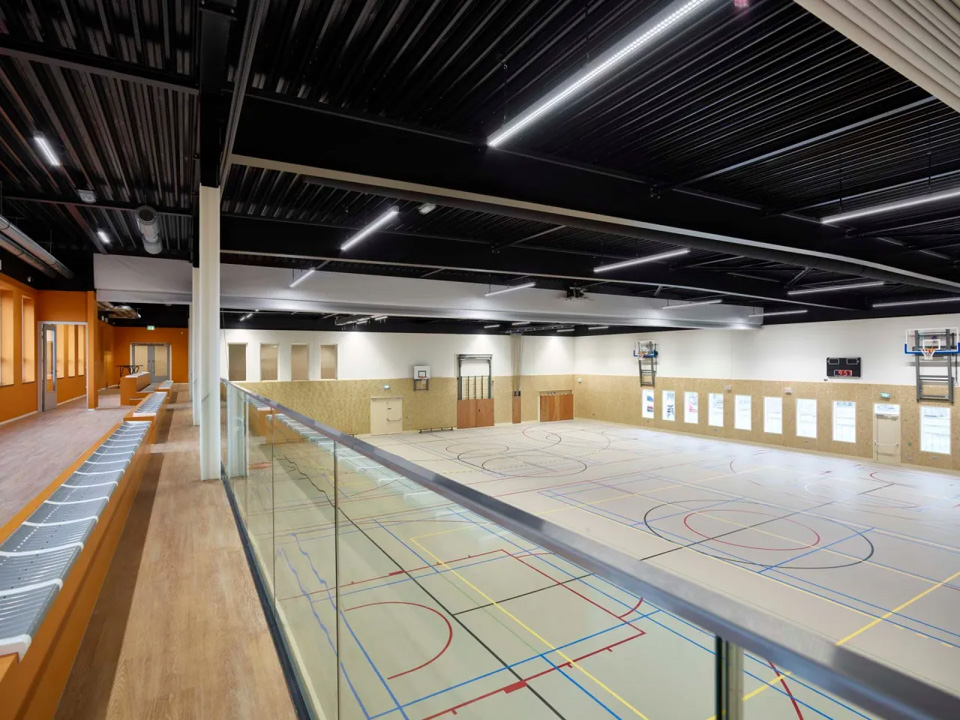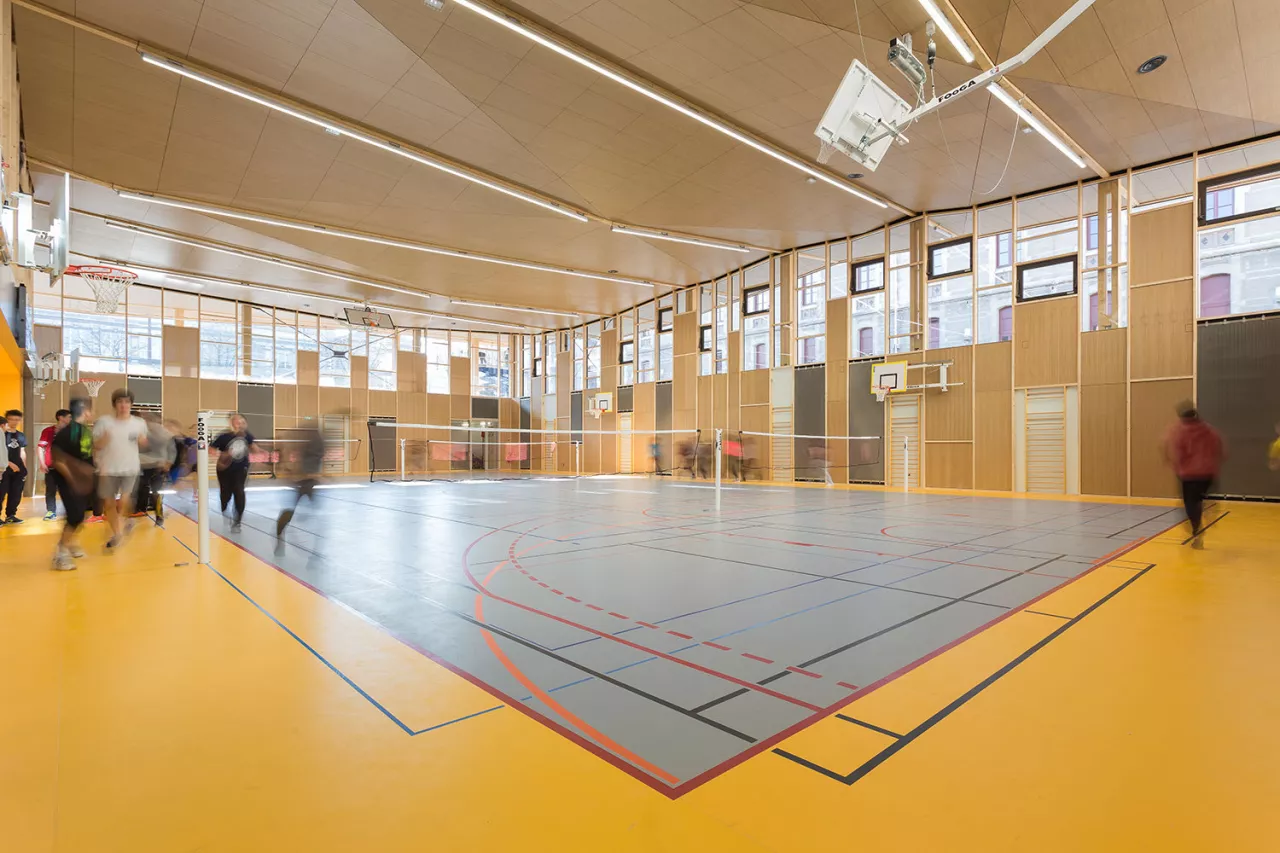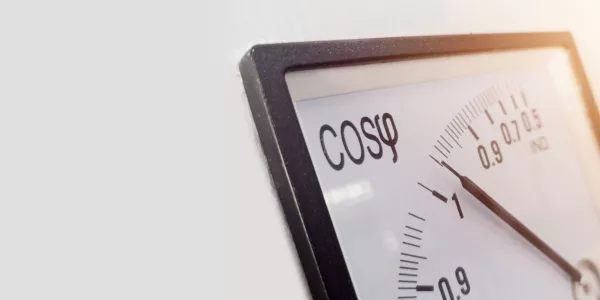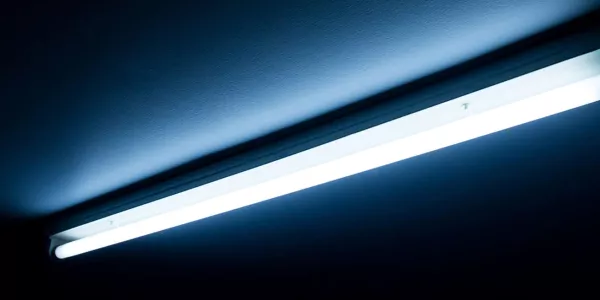This is how to choose the perfect lighting for a sports hall
Want to optimise the lighting of a sports hall or sports facility? That's an excellent plan, as the right lighting is essential for the comfort of athletes and spectators and important for the quality of any match shots. But how do you choose the right lighting? We will help you on your way.

Reading time: 5'00"

What do you pay attention to when choosing sports hall lighting?
Some key points to consider:
- What sport is being played? Each sport requires different lighting. Players of fast-moving sports, such as football, for example, need more light to keep track of the ball at all times. In an omni sports hall where multiple sports are played, it can be a challenge to meet all the requirements.
- Players' visual comfort. Although athletes need plenty of light, you want to avoid glare. You certainly don't want spots of light to burn afterglow on their retinas. This is especially important in sports like tennis or badminton, where players often look upwards.
- Don't forget the spectators. They need sufficient light to find their seats, but above all to be able to follow the match properly. Again, avoid glare.
- Ball-proof luminaires. Make sure the lighting can withstand balls impacting the fixtures at full force. Choose fixtures that are certified ball-proof, so that parts will not become loose or fall down.
- Will matches be filmed? If matches are filmed, take into account the position of the cameras. Furthermore, you want to avoid reflections, eliminate flickering light and ensure sufficient vertical light intensity.
- Go for longevity and low energy consumption. Sports halls are used intensively and often last for decades, so choose energy-efficient solutions that last.

NBN EN 12193: the standard for sports field lighting
In many cases, you can request specifications from your sports federation. Also helpful is the NBN EN 12193 standard for sports field lighting from the Standardisation Agency. It indicates which lighting is suitable for each type of sport and level of competition.
Distribution of light in the sports hall
To determine the correct lighting levels in a sports hall and measure them accurately, the NBN EN 12193 standard defines a measurement grid, also called a "grid". This grid consists of a series of measurement points evenly distributed over the playing field. In addition, the standard distinguishes between two different surfaces:
- PA: Principal Area
This is the principal area, or the sports field itself as delineated by the lines. Lighting in this area has to meet the specific requirements of the sport.
- TA: Total Area
This area is larger than the sports field and is often used by athletes to, for example, chase a ball that would otherwise be "out". Adequate lighting should also be provided in this area.

Some examples:
|
Reference surface |
Number of grid points |
||||
|
Length |
Width |
Length |
Width |
||
|
Badminton |
PA |
13,4 m |
6,1 m |
11 |
5 |
|
TA |
18 m |
10,5 m |
11 |
7 |
|
|
Basketball |
PA |
28 m |
15 m |
13 |
7 |
|
TA |
32 m |
19 m |
15 |
9 |
|
|
Gymnastics |
PA |
32 tot 50 m |
18,5 tot 10 m |
13 tot 15 |
9 |
Brightness in the sports hall
The standard also further defines how bright the light should be for different types of sports competitions.
- Class I: Competition at the highest level, usually with many spectators.
- Class II: Regional and local club competitions, or training for top competition.
- Class III: Local competition, mostly without spectators; school sports and recreational sports.
For each class, it describes exactly how much light should be on the playing field (PA, Principal Area) and how even that light should be. For badminton, for example, it must be 750 lux at Class I, but only 300 lux at Class III.
For the TA (Total Area), the light level and uniformity must be at 75% of the values of the PA (Principal Area).
|
|
Required on PA (Principal Area) |
||
|
Illuminance |
Evenness |
||
|
Badminton |
Class I |
750 lux |
0,70 |
|
|
Class II |
500 lux |
0,70 |
|
|
Class III |
300 lux |
0,70 |
|
|
|
|
|
|
Basketball |
Class I |
750 lux |
0,70 |
|
|
Class II |
500 lux |
0,70 |
|
|
Class III |
200 lux |
0,50 |
|
|
|
|
|
|
Gymnastics |
Class I |
500 lux |
0,70 |
|
|
Class II |
300 lux |
0,60 |
|
|
Class II |
200 lux |
0,50 |
These sports hall lighting guidelines guarantee that athletes perform optimally, regardless of their level.
Safety first: ball resistance of sports hall lighting
Lighting in sports facilities must be sturdy. Luminaires that comply with international standards such as German DIN 18032-3 and DIN 57710-13 are specifically tested for their resistance to hard balls.
The tests are done with a ball-shooter. After 36 handball shots from three directions, at a speed of about 60 km/h, the luminaires should show no serious damage. In particular, the lamps should not break and no parts should come loose.
How to prevent glare in a sports hall?
Glare can firmly disrupt the game, both for athletes and spectators. Fortunately, there are effective solutions:
- Choose luminaires that prevent peak luminance to reduce glare.
- Avoid highbay luminaires where the LEDs are visible as bright blinding dots.
- Go for luminaires with a low UGR (Unified Glare Rating) value. The lower the UGR value, the less glare.
- For optimal visual comfort, choose luminaires with a UGR value below 22, which also meets the EN 12464-1 standard for school gymnasiums.
- Place your luminaires smartly: in sports where players often look up, it is best to place lighting next to the playing field, not above it.
Optimise your energy consumption with LED lighting
Sports halls have a long lifespan and lighting in sports halls is used intensively, so it is smart to choose sustainable lighting. LED lighting with a high LLMF (Light Lumen Maintenance Factor; maintaining the initial luminous flux) and high energy efficiency is the best choice. With LED luminaires, the driver is often the first component to fail, so make sure it is easy to replace.

E7 luminaires: the best choice for sports hall lighting
Our recommendation? Choose ETAP's E7 luminaires with the patented LED+LENS™ technology that ensures light is evenly distributed across the lens. As a result, you won't see any interfering light points, but you will experience optimal lighting. With a low UGR value, high energy efficiency and easy access for maintenance, the E7 is the perfect choice for sports halls. In addition, these luminaires pass the ball test with ease - as confirmed in this test report - and offer optimal visual comfort.
In short, you will definitely score with ETAP's E7 luminaires!
Want to know more about how to optimally light your sports hall? Check out our successful projects and get inspired by the sports halls we have already provided with the best lighting.

Adriaan Van Nuffel is our product manager for industrial and emergency lighting. Every day, he enthusiastically explores the latest technologies and trends, seeking innovative solutions to fulfill the lighting needs of the market. This way, ETAP continues to stay ahead in the lighting market.
Contact:
+32 (0)3 310 02 11 [email protected]



